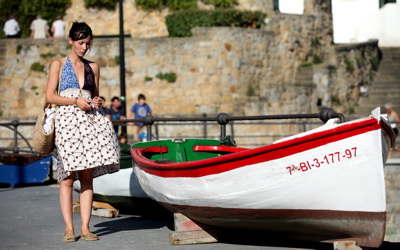
Teresa Parker blogs about restaurants, recipes, and the reasons why she's in love with Spain's food and culture.

The Guggenheim museum in Bilbao is still a thrill. But because of that it’s hard for the city itself to get the buzz it deserves.
“Maybe it’s just as well,” says my Bilbaina friend Carmen. “At least Felipe and I can always get a table here.”
Carmen was sipping a coffee on the terrace of her favorite asador (a grill—the Basques are big on cooking with fire). There were sweeping views of the city—tile roofs, glass towers, and green hills—just behind her. We had put away more than our fair share of juicy mushrooms, sweet grilled peppers, and perfectly rare ribeyes. The restaurant was busy. But not buzzy.
I was humbled. In a country bright with Michelin stars, this asador didn’t have one. I hadn’t read about it in any magazine. But it was very, very good.
This is where it dawned on me that Bilbao is a great place to live.
And why wouldn’t it be? It’s a city with an adventurous and industrious past. The people here started mining iron in the middle ages and ran a fishing empire even before that. It’s been a university town since the 1800s. Obviously there was something to this place before the Guggenheim came along in 1997.
I knew Carmen didn’t really mean it about wanting Bilbao to stay undiscovered. She has her own boutique travel company in town—she’s my go-to local expert in the Basque Country. And she loved surprising me with that asador experience.
She promised to show me more of her best beyond-the-Guggenheim secrets.
Bilbao being compact and walkable, the first thing, naturally, was browsing shoes. We met in her elegant 19th century Ensanche neighborhood, on the streets around Plaza Moyua. Red suede oxfords called out to me from Lottusse—they’re hand-sewn in Mallorca. I’m not sure she liked them, but Carmen endorsed them in her practical Basque way: “They’ll last forever.”
Next thing you know we were at Pastelería Arrese (est. 1852), sampling a chocolate truffle.
“I also love Pastelería Martina de Zuricalday,” says Carmen. “It’s the oldest pastry shop in Bilbao, founded in 1830.” Her advice on what to get there: the bollo de mantequilla—a perfect little brioche oval filled with whipped sweet butter.
Here is just some of the other off-tour places Carmen showed me, pared down to my top ten, on a loop that starts in the 19th century Ensanche, zig-zags into the historic Parte Vieja, and includes a jaunt—or if there’s time, a daytrip—to the sea.
- The Alhóndiga, newly renamed the Azkuna Zentroa. A 1905 wine warehouse that had been abandoned since the 1970s came alive as a community center in 2010 with a redesign by Philippe Starck. The pillars are fun. But don’t forget to look up: there’s a glass-bottomed public pool on the top floor.
Jardines de Albia. Not a tourist site, but a slice of the good life: a leafy, park-like square and remnant of a time when the neighborhood of Abando was its own separate town (it became part of Bilbao in the late 1800s). Café Iruña is here, with beyond kitsch turn-of-the-last-century tile. A good stop for a pick-me-up.
Catedral de Santiago. Initially finished in 1379, this church is an important stop for pilgrims on the northern route of the Camino de Santiago. In spite of a 19th century neo-gothic façade and Renaissance porticoes built after a fire in the 1500s, there’s a beautiful gothic cloister inside.
- Gorostiaga. The place to buy a fine-quality wool Elosegui Basque beret, here more properly called a txapela. The ones with the leather band are really superior—let the shopkeepers help you find just the right fit.
Plaza Nueva. The city’s neoclassical arcaded plaza with excellent pintxos possibilities all around. Alex Raij, chef and owner of the Basque restaurant Txikito in New York City is a fan of Gure Toki. She’s not alone. If you’re tuckered out from travel, a dinner of made-to-order bites at a marble table downstairs at Victor Montes is perfect.
Zubizuri. Santiago Calatrava’s pedestrian bridge over the Nervión is most striking at night. Its flaws are interesting, too. The architect envisioned a glass walkway, but that proved too slippery, so it’s covered with safety strips. He also intended elegantly long ramps but more convenient chunky ones had to be added.
Museo de Bellas Artes. In a serene setting right near the Guggenheim, Bilbao’s Fine Arts collection spans medieval to modern masterpieces, including lots of Spanish works from El Greco to Goya. On Sundays at noon there’s a tour focused on Basque art.
Bilboats. Get a sense of Bilbao’s relationship to the Atlantic by sailing (well, motoring) out the ría, the estuary of the River Nervión. A one-hour trip takes you as far as Zorrozaure—where massive rusting chains that once anchored ships make for art on a landscape that is now being re-envisioned by Zaha Hadid. In two hours you can go all the way to Portugalete and back.
El Puente Colgante. The Hanging Bridge (officially Puente Bizkaia) where Bilbao meets the coast is an industrial age masterpiece spanning the Nervión to connect the towns of Portugalete and Getxo. Take the subway L1 to the Areeta stop in Getxo. Walk across it to really get its beauty.
Algorta. Take a long walk along the waterfront from the Puente Colgante, where the last century’s industrialists built their mansions. You’ll pass a modern marina, then a wide urban beach. At the end, a bar perched on a sunny staircase welcomes you, with a beer and a bite, to a wander in this tiny bit of old port. Also reachable by subway (L1 to Neguri).
Here’s what I really like best about Bilbao: it’s a city where people are as comfortable with their old-school pintxos bars as they are with their shiny titanium museum. It’s hospitable without being showy.
What about that asador? I’m not telling how to find it. Not right here, anyway. But when a Bilbaina says, nonchalantly, “There’s this place up the hill—I think you might like it,” follow her.
